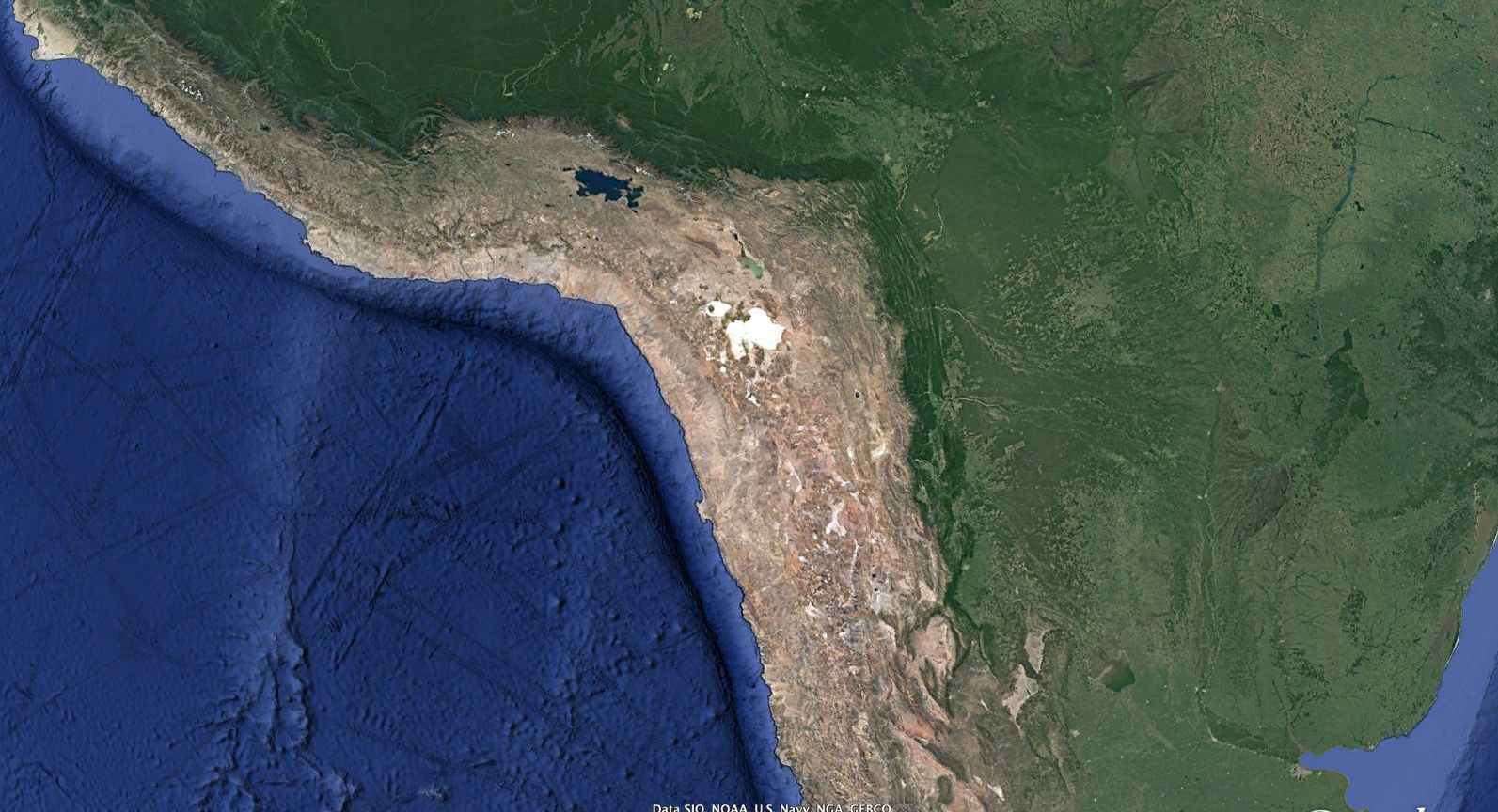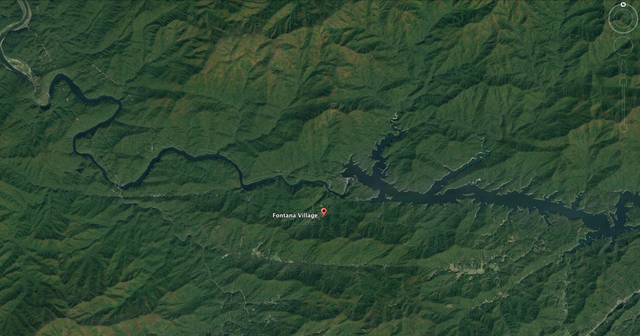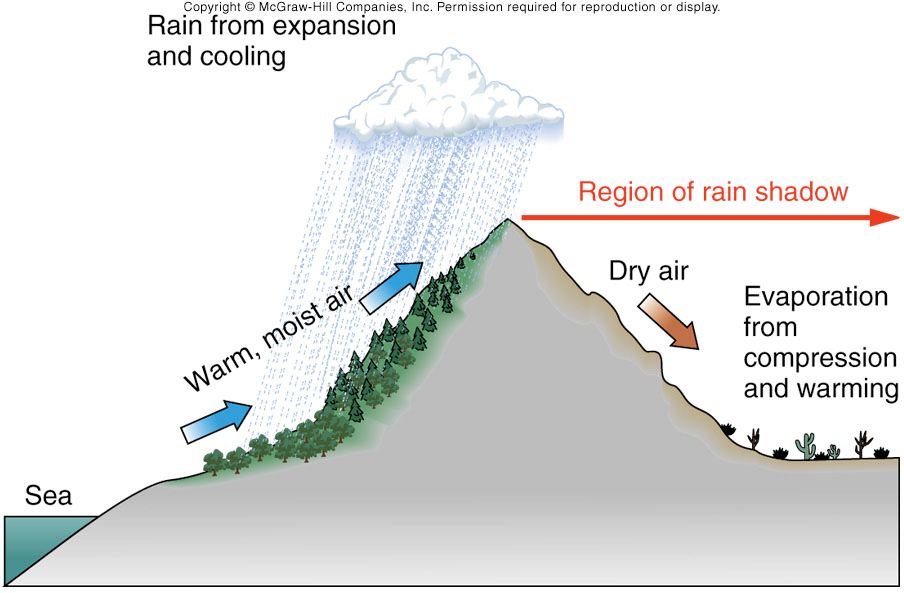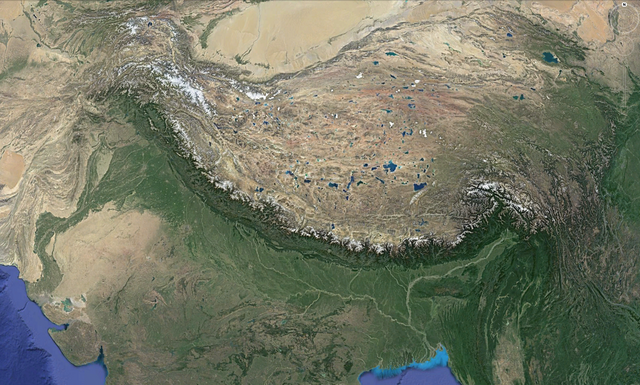The Effects Geological Features Have On Climates: Mountains & Rain Shadows
One of the biggest reasons I decided to start studying geology in college was largely due to the fact, that throughout my life and all the places I lived, I couldn’t help but notice the effect mountains had on regional weather patterns and climates. As a child I lived in a small town called Fontana Village, NC. It was located in western North Carolina in the Smoky Mountains of the Appalachians. Our family home was at an altitude of around 1,700 feet and the surrounding ridges were roughly 3,300 ft. Like any child born and raised in Florida, I was always observant (overly excited) of the snow when it came rolling into the mountains.
 Satellite imagery of a small section of the Andes Mountains in South America. A great example of the rain shadow effect taking place. [Image Source]
Satellite imagery of a small section of the Andes Mountains in South America. A great example of the rain shadow effect taking place. [Image Source]
Nearly every single time I’d watch the snow slowly make it’s way down from the ridges to the lower altitudes. While that progression down the mountainside occurred, our home would typically receive a cold light rain or mist. There were a few times me and my sister decided to walk to the top of the ridge and went to a peak called, Lookout Rock. We wanted to test our theory that there would be more snow at the higher elevations. Sure enough, the ridge line had roughly 1-3 inches of snow on average, while our home would have a dusting at most. It was almost as if the mountains squeezed the snow out of the clouds like a sponge. In actuality, this is exactly what was taking place.
I suppose to the more seasoned geology student, this comes as no surprise. However, to a couple kids from Florida (much warmer climate), no older than 11 years old, this was sort of a big deal. We didn’t know the exact science behind it, but that’s all science truly is–using what senses you have at hand to arrive at a conclusion. Regardless, it was moments such those, accumulated over a lifetime, that helped me realize how much I appreciate geology, meteorology and science as a whole.
 Satellite imagery of the Smoky Mountains. Fontana Village is on the north mountain face. These ridge lines were of but a few in the region that are east to west. [Image Source]
Satellite imagery of the Smoky Mountains. Fontana Village is on the north mountain face. These ridge lines were of but a few in the region that are east to west. [Image Source]
Okay, now that I’m done romanticizing my love for geology, let’s move on to the main topic at hand– rain shadows. If you look at the picture I shared above, you’ll see a small town called Fontana Village, which resides on the north face of the mountain. While I plan to talk more about this area from a historical and geological perspective in a future post; today I will simply use it as an example of how a rain shadow takes place. It’s not the best example, but it’s a great place to start.
As I mentioned earlier, the ridgeline south of Fontana Village typically accumulated more snow than where my family home was located. Interestingly enough, another observation I made as a kid, was that the valley on the other side of the ridge to the south, which is called Yellow Creek, received little to no snow. This only occurred if the snow bands that were moving into the region came from a North/Northwest to South/Southeast direction. Little did I know, but a rain shadow effect was taking place, but at the micro level. It should be noted that the Appalachian Mts. of western North Carolina are well known for their microclimates.

Simplified illustration of how a rain shadow occurs. [Image Source]
So what is a rain shadow? It is the dry area on the leeward side of a mountainous region. As an air mass approaches the side of a mountain, orographic lifting takes place. Orographic lifting occurs when an air mass from a lower elevation is forced upward to higher elevations, due to it moving over rising terrain. When the lifting takes place, warm air, which carries significantly more moisture than cool air, begins to expand due to a decrease in atmospheric pressure and will then cool down adiabatically. This causes precipitation to occur; allowing the higher altitudes of the windward side of the mountainous region to act as a sort of precipitation collector, scraping the moisture from the air mass.
On the leeward side of the mountainous region, the cool and relatively-dry air that is leftover, begins to descend. When this occurs, the air begins to warm up due to adiabatic compression. This increases the amount of moisture the air mass can absorb. As a result, you’re typically left with a dry and arid region.
 Satellite imagery of the Himalayan Mountains. [Image Source]
Satellite imagery of the Himalayan Mountains. [Image Source]
The effects of a larger rain shadow are much more pronounced in other regions of the world. A great and very straight forward example of a rain shadow occurring is the Himalayan Mountains. The satellite image I provided above shows the stark contrast in wetter and dryer climates. As the warm and moist air from the Indian Ocean is uplifted on the windward side of the Himalayan Mountains, the same process I described earlier takes place. There are other examples of rain shadows occurring on Earth–Sierra Nevada Mountains, Appalachian Mountains, Andes Mountains, Madagascar– and each one shows how much of an impact mountain ranges or rises in land have on the regional weather patterns and climates.
 Snow accumulation on the western front of the Appalachian Mountains. Note the difference in accumulation from west to east in contrast to the mountain range. [Image Source]
Snow accumulation on the western front of the Appalachian Mountains. Note the difference in accumulation from west to east in contrast to the mountain range. [Image Source]
The main reason I wanted to discuss rain shadows, is in large part due to the fact I'm currently living in one! In Roanoke, VA we are currently experiencing the second driest winter in recorded history. While this is great news for people who despise snow, the rain shadow effect stopped us from having a white Christmas and a weeks worth of snow. With that being said, I appreciate the lack of snow giving me the opportunity to wrap my head around the processes that occur in order for a rain shadow to take place.
If you enjoyed this post, be sure to check out my other posts on the New Madrid Seismic Zone and Why the Pacific Northwest of America Has Volcanoes.
Bibliography:
https://en.wikipedia.org/wiki/Rain_shadow
https://en.wikipedia.org/wiki/Orographic_lift
https://en.wikipedia.org/wiki/Adiabatic_process
http://www.virginiaplaces.org/geology/rainshadow.html
Giving out free votes to the little guys, I hope you appreciate.
It's much appreciated! Thanks for helping us minnows out. :)
People always blaming me for their lack of rain. Slander, I tell you! :D
Great post, I really enjoyed it!
Haha! Thanks, I'm glad you enjoyed it. :) I think I'm going touch up on this subject a little more down the road. Happy New Years!
why is it that some mountains produce this rain shadow, while others don't seem to do? I grew up in the alps, and never had the impression that one side suffered from less rain or snow. Is it because the wheater can come from both sides? Or are they not high enough?
Nice write-up btw, upvoted/followed
Hey there! Thanks for the upvote and follow. I gave you a follow back as well. As for your question– From what I understand, the Alps in all likelihood don't suffer from a significant rain shadow effect due to the flow of the jet stream. It's bring warm air from the Atlantic heading south and then dips into the Mediterranean, switching to a northward trend afterwards. This would bring more warm air and moisture along with it, causing the process to happen again, but from a south to north trajectory. With that being said, I would assume that northern Italy has some form of rain shadow, but only seasonally. My only conclusion as to why this may be the case, is because Italy is well known for their grapes grown in the northern regions of the country. You'll typically see grapes grown in Mediterranean climates, which have an arid climate during the summer time. With that being said, I'll have to dig deeper on this topic. Maybe I'll touch up on this a bit more and have Europe and the Alps be the focus!
when it comes to grapes, I have to tell you we grow them in south-eastern austria aswell ;-)
But ty for the answer!
Well, that actually makes a lot sense. South eastern Austria has longer and warmer summers compared to the rest of the country– comparable to a Mediterranean climate. When I write my next post on this subject, I'll be sure to tag you. Thanks again!
@originalworks
The @OriginalWorks bot has determined this post by @keephy to be original material and upvoted it!
To call @OriginalWorks, simply reply to any post with @originalworks or !originalworks in your message!